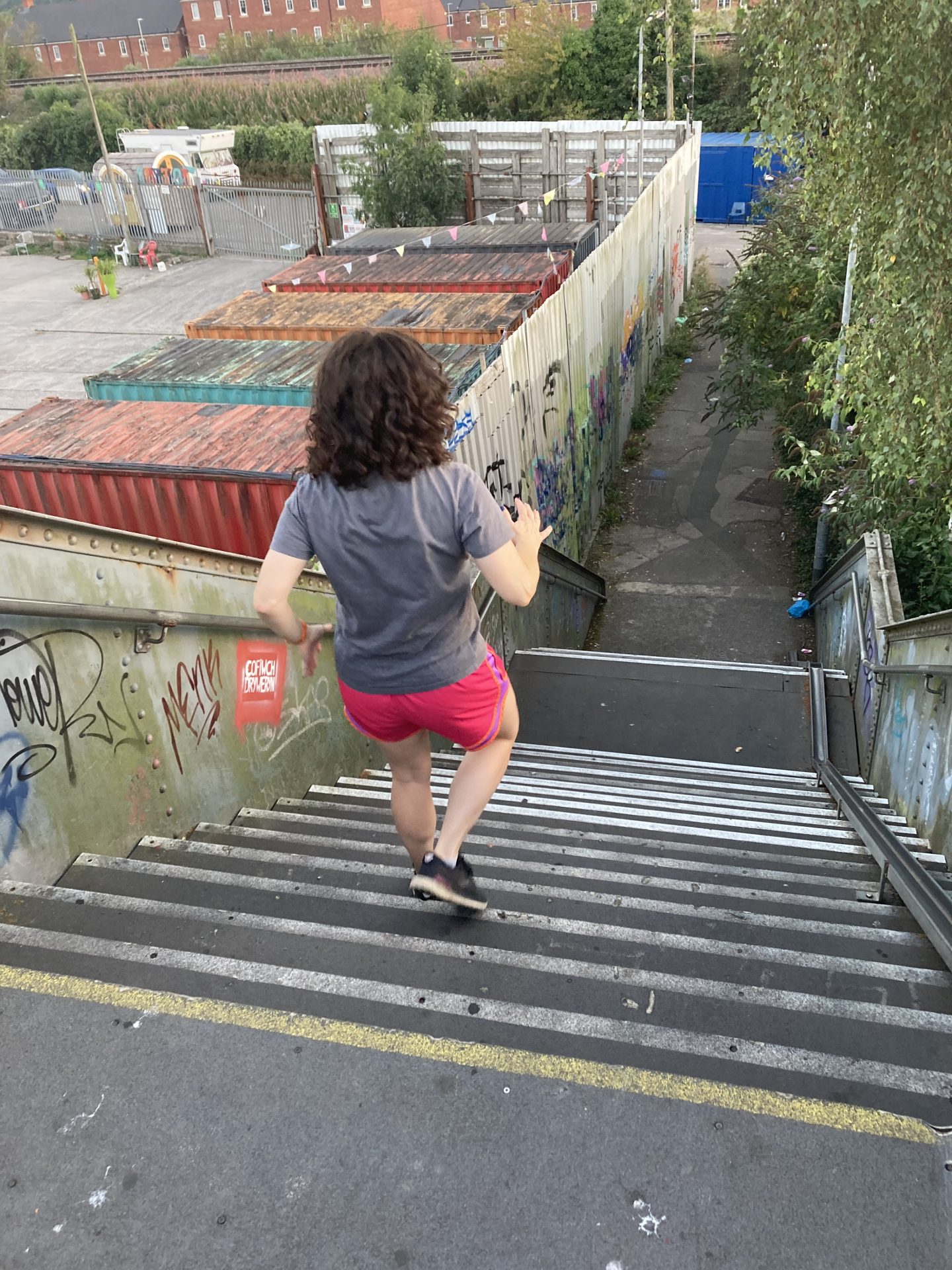“I've never been as fit as when I used to run up the stairs in my office”

Think you’ve got to invest in a fancy gym or start running marathons to get a great cardio workout? Think again. All you need to get seriously fit is a set of (carpet-free) stairs and a pair of trainers, as writer Jennifer Burns has been finding out.
“Just be grateful you don’t have to do it five times in a weighted vest,” my brother, John, told me as we hurled ourselves up yet another flight of stairs in a South Florida parking garage in the autumn heat. “Or carry a 3st hose pack with you.”
My brother is a hench firefighter who climbs buildings for a living. I, on the other hand, was dying from running up a flight of stairs. At the time, in 2018, I considered myself pretty fit for a 37-year-old: I’d run the London marathon in 2009 and five half marathons since. But I couldn’t dart up steps without feeling like my heart was going to explode out of my chest.
Still, I was hooked – my masochistic rationale being that anything which makes me feel this bad had to make me stronger down the line. I spent the rest of my family visit running stairs every other day.
You may also like
Running: 5 treadmill workout tips to mix up your cardio training
Stair running builds power, speed, balance, flexibility and endurance
Stair running engages every major muscle in your lower body: glutes, hamstrings, quadriceps, calves and abs.
“The drive from your arms and shoulders when you’re trying to generate some extra power also gives that upper body a good tweak too,” says Anna Reich, personal trainer and former bodybuilding champion.
You have to work against gravity, so you’re challenging your cardiovascular system and strength training at the same time. “What makes stair running particularly effective is that it addresses all five pillars of physical fitness: power, speed, balance, flexibility and endurance,” Reich explains.
A 2005 study published in the British Journal of Sports Medicine revealed how, after sedentary women took part in an eight-week progressive stair climbing programme, they increased their VO2max by 17.1% and reduced their low-density lipoprotein cholesterol by 7.7%.

It’s free and readily accessible (if you have a high embarrassment threshold!)
It’s a versatile workout that you can do anywhere – at home (be careful not to trip on carpeting!), or, if you’re like me and don’t care what your colleagues think of you, in the stairwells of your office building.
“Running stairs provide all you need to stay in good, all-round, physical health – no gym fee needed,” says Reich.
It’s that which was part of the appeal for me. Back in the UK, I didn’t want to shell out the cash for a monthly membership (and I’m a big hater of treadmills anyway) – so after work, I started running steps in my brightly lit, heated, eight-floor office building. Over the subsequent months, I even roped in others to join me.
I had never been fitter.
Stair running is great for runners
If you’re a seasoned runner, incorporating stair workouts into your regime could take your fitness to the next level.
“A stair workout addresses your cardio, but it also builds the muscles you need to drive forward and run faster and longer,” Reich says. “It engages your ‘fast twitch’ muscle fibres – those you need for quick and explosive movements, like sprinting, as well as your ‘slow twitch’ ones, which you need for endurance, like running marathons.”
How to get started, safely
No matter how fit or coordinated you are, running stairs can be dangerous. When you’re ready to start a regime, go at your own pace and progress in increments… otherwise, you risk slipping, missing a step, catching your foot or your knee and falling. Reich recommends wearing knee and elbow pads at first, just to be safe.
“Get familiar with your chosen staircase by doing the simpler moves first, like going up marginally faster, then down at a normal pace and then jumping to the ground from the final step,” says Reich. “You can take it one step at a time, literally, and then go up to two, three or more steps, depending on your height, leg length and confidence.”
There’s also a risk of damaging your knee: “Avoid overreaching on your step to the point where your knee rises beyond a 90° angle — it’ll overload the knee and possibly cause an injury,” Reich points out. “When you do that, you’re not engaging the leg muscles and glutes as much. It’s more of a pressurized lever situation.”
Always be sure of foot placement and pay attention to your surroundings – pedestrians should always have the right of way. Avoid busy or dimly lit stairs, loose carpets or damaged steps.

Ways to make your stair running regime even more challenging
Once you’ve got the basics down, you can try ascending faster or extending your workout by tackling more flights of stairs. Reich recommends the latter, as it’s safer.
How many steps you take at a time depends on your fitness goals: “Most people can go up one faster than two or three, so you will expend more energy through the speed element. Taking ‘giant’ steps maybe won’t burn as many calories, but it will build your lean muscle, which over time, burns more calories at rest.”
She also suggests increasing the intensity by carrying more weight, which you can do by wearing a running rucksack with some added ‘non-bouncy’ weight inside, strapping on ankle or wrist weights, or donning a weighted vest (the best option to stimulate muscle growth).
I’ve since left my job with the perfect office staircases, and I’ve taken to running steps outside, which has its own benefits. I’ll probably never be able to out-climb my fit firefighter sibling, but I may be able to keep up with him if I can just get my hands on one of those fancy weighted vests.
Anna’s 15-minute stair workout for beginners
Warm-up
Repeat the below twice, in order. If you don’t want to try a supported squat, just go for a simple air squat.
- Squat x 10: Wrap a towel around the top of your balustrade (TRX-style), and use it to support a squat (strength move)
- Squat jumps x 10: As above, but with a mild or deep jumping action (power move)
- Plank walks (40 seconds): Plank in front of your first step (knees or full plank) and walk your hands up as many steps as you can, then go back down again. You can do narrow and wide walks to challenge your body in different ways (strength and endurance move)
Main session
Again, repeat the following five exercises twice, in order. If you don’t fancy the toe taps, try the 40-second sprint option.
- Giant steps (up to eight steps): Take as big a step up as you can, ensuring your knee is at a 90-degree angle, and drive yourself up. Use the wall or hand-rail for support, if you need to (strength and flexibility move)
- Crab walks x 10: Stand slightly crouched side-on to your stairs and go up until you’ve taken about four steps with the leading leg. Then, jog down and go up using your other leg to lead (strength, speed and balance move)
- Tricep dips: Sit on your lower step with your back to the staircase. Keep your hands close to your sides and fingers wrapped around the step. Without allowing your elbows to flare out, lower your bottom off the step and then drive back up (strength and flexibility move)
- Calf raises x 10: Stand on your lower step with your arch and heels off the step. Rise as high as you can onto your toes then lower as far you can (balance and strength move)
- Toe taps (40 seconds): Slightly lean back, tap the step with one foot, then quickly swap with the other foot. Do this with a jump in your step as you swap feet, if you can (speed and endurance move)
OR you can do a sprints HIIT for 40 seconds: Go up as fast as you can, then descend at your normal pace (speed and endurance move)
Ready to start stair running? Check out our library of How-to videos first to get familiar with the kinds of strength moves that can help to keep you injury-free.
Images: author’s own
Source: Read Full Article